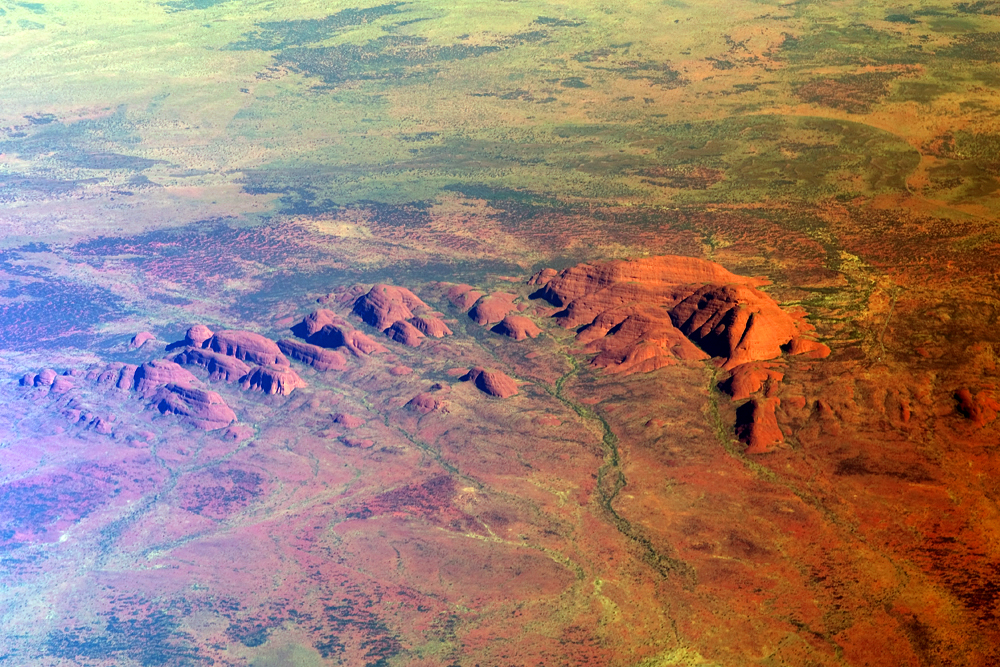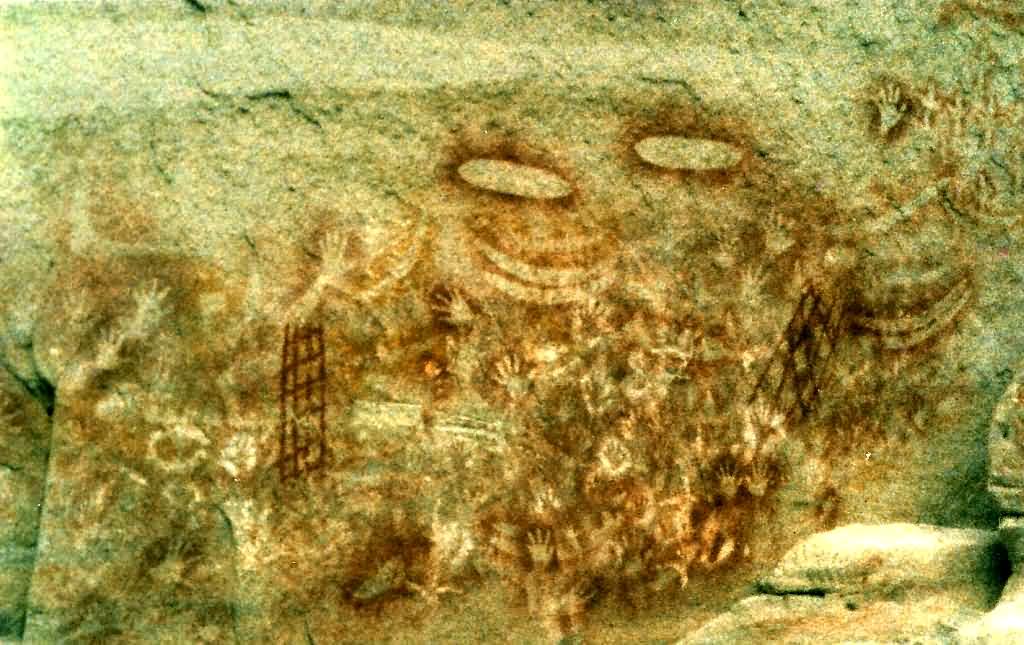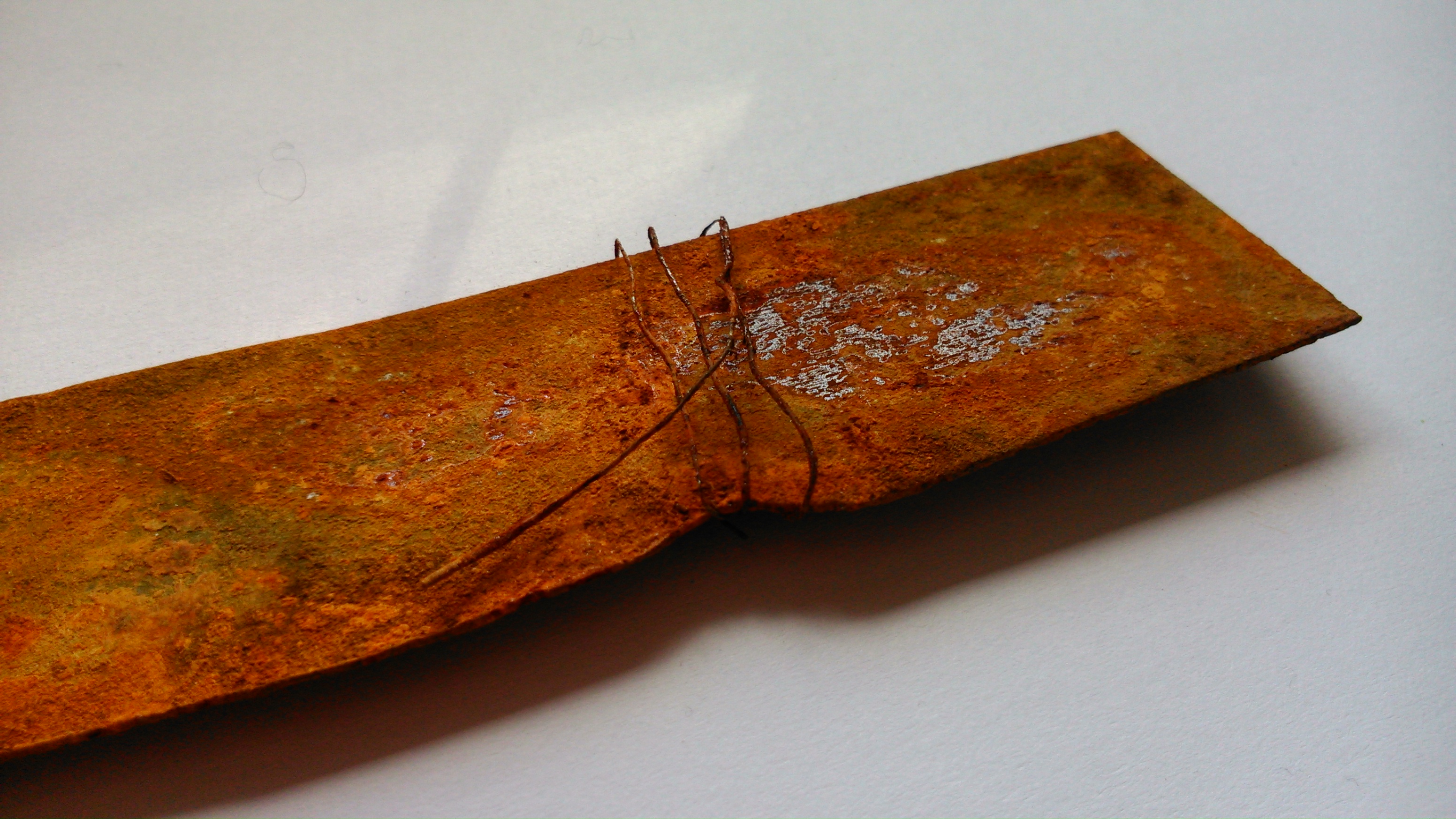|
Uluṟu
Uluru (; ), also known as Ayers Rock ( ) and officially gazetted as UluruAyers Rock, is a large sandstone monolith. It crops out near the centre of Australia in the southern part of the Northern Territory, south-west of Alice Springs. Uluru is sacred to the Pitjantjatjara, the Aboriginal people of the area, known as the Aṉangu. The area around the formation is home to an abundance of springs, waterholes, rock caves and ancient paintings. Uluru is listed as a UNESCO World Heritage Site. Uluru and Kata Tjuta (Also known as the Olgas) are the two major features of the Uluṟu-Kata Tjuṯa National Park. Uluru is one of Australia's most recognisable natural landmarks and has been a popular destination for tourists since the late 1930s. It is also one of the most important indigenous sites in Australia. Name The local Aṉangu, the Pitjantjatjara people, call the landmark ''Uluṟu'' (). This word is a proper noun, with no further particular meaning in the Pitjantjatjara ... [...More Info...] [...Related Items...] OR: [Wikipedia] [Google] [Baidu] |
Kata Tjuta
Kata Tjuṯa ( Pitjantjatjara: , lit. 'many heads'; ), also known as The Olgas and officially gazetted as Kata TjutaMount Olga, is a group of large, domed rock formations or bornhardts located about southwest of Alice Springs, in the southern part of the Northern Territory, central Australia. Uluṟu / Ayers Rock, located to the east, and Kata Tjuṯa / The Olgas form the two major landmarks within the Uluṟu-Kata Tjuṯa National Park. The park is considered sacred to the local Aboriginal community. The 36 domes that make up Kata Tjuṯa / Mount Olga cover an area of are composed of conglomerate, a sedimentary rock consisting of cobbles and boulders of varying rock types including granite and basalt, cemented by a matrix of coarse sandstone. The highest dome, Mount Olga, is above sea level, or approximately above the surrounding plain ( higher than Uluṟu). [...More Info...] [...Related Items...] OR: [Wikipedia] [Google] [Baidu] |
Uluṟu-Kata Tjuṯa National Park
Uluṟu-Kata Tjuṯa National Park is a protected area in the Northern Territory of Australia. The park is home to both Uluru and Kata Tjuta. It is located south of Darwin, Northern Territory, Darwin by road and south-west of Alice Springs along the Stuart and Lasseter Highways. The park covers and includes the features it is named after: Uluru and, to its west, Kata Tjuta. The location is listed as a UNESCO World Heritage Site for natural heritage, natural and cultural landscape. Overview Uluru / Ayers Rock is considered one of Australia's most recognisable landmarks, and has become a focal point for Australia and the world's acknowledgement of Australian indigenous culture. The sandstone monolith stands high with most of its bulk below the ground. To Anangu, the local indigenous people, Uluru / Ayers Rock is a place name and this "Rock" has a number of different landmarks where many ancestral beings have interacted with the landscape and/or each other, some even believed ... [...More Info...] [...Related Items...] OR: [Wikipedia] [Google] [Baidu] |
Northern Territory
The Northern Territory (abbreviated as NT; known formally as the Northern Territory of Australia and informally as the Territory) is an states and territories of Australia, Australian internal territory in the central and central-northern regions of Australia. The Northern Territory shares its borders with Western Australia to the west (129th meridian east), South Australia to the south (26th parallel south), and Queensland to the east (138th meridian east). To the north, the Northern Territory looks out to the Timor Sea, the Arafura Sea, and the Gulf of Carpentaria, including Western New Guinea and various other islands of the Indonesian archipelago. The NT covers , making it the third-largest Australian federal division, and List of country subdivisions by area, the 11th-largest country subdivision in the world. It is sparsely populated, with a population of only 249,000 – fewer than half the population of Tasmania. The largest population centre is the capital city of Darw ... [...More Info...] [...Related Items...] OR: [Wikipedia] [Google] [Baidu] |
Dual Naming
Dual naming is the adoption of an official place name that combines two earlier names, or uses both names, often to resolve a disagreement over which of the two individual names is more appropriate. In some cases, the reasons are political. Sometimes the two individual names are from different languages; in some cases this is because the country has more than one official language, and in others, one language has displaced another. In several countries, dual naming has begun to be applied only recently. This has come about in places where a colonial settler community had displaced the indigenous peoples and started using names in the settler language centuries ago, and more recent efforts have been made to use names in the indigenous language alongside the colonial names, as an act of reconciliation. Afghanistan In Afghanistan, the name 'Dari' replaced Persian (Farsi) after the 1964 constitution which was the only official language until the approval of the constitution in ... [...More Info...] [...Related Items...] OR: [Wikipedia] [Google] [Baidu] |
Pitjantjatjara
The Pitjantjatjara (; or ) are an Aboriginal people of the Central Australian desert near Uluru. They are closely related to the Yankunytjatjara and Ngaanyatjarra and their languages are, to a large extent, mutually intelligible (all are varieties of the Western Desert language). They refer to themselves as Anangu (people). The Pitjantjatjara live mostly in the northwest of South Australia, extending across the border into the Northern Territory to just south of Lake Amadeus, and west a short distance into Western Australia. The land is an inseparable and important part of their identity, and every part of it is rich with stories and meaning to aṉangu. Pronunciation The ethnonym ''Pitjantjatjara'' is usually pronounced (in normal, fast speech) with elision of one of the repeated syllables ''-tja-'', thus: ''pitjantjara''. In more careful speech all syllables will be pronounced. Etymology The name ''Pitjantjatjara'' derives from the word ''pitjantja'', a nominalise ... [...More Info...] [...Related Items...] OR: [Wikipedia] [Google] [Baidu] |
Arkose
Arkose () or arkosic sandstone is a detrital sedimentary rock, specifically a type of sandstone containing at least 25% feldspar. Arkosic sand is sand that is similarly rich in feldspar, and thus the potential precursor of arkose. Components Quartz is commonly the dominant mineral component, and some mica is often present. Apart from the mineral content, rock fragments may also be a significant component. Arkose usually contains small amounts of calcite cement, which causes it to effervesce (fizz) slightly in dilute hydrochloric acid; sometimes the cement also contains iron oxide. Colouration and presence of fossils Arkose is typically grey to reddish in colour. The sand grains making up an arkose may range from fine to very coarse, but tend toward the coarser end of the scale. Fossils are rare in arkose, due to the depositional processes that form it, although bedding is frequently visible. Formation process Arkose is generally formed from the weathering of feldspar-rich igne ... [...More Info...] [...Related Items...] OR: [Wikipedia] [Google] [Baidu] |
Sandstone
Sandstone is a Clastic rock#Sedimentary clastic rocks, clastic sedimentary rock composed mainly of grain size, sand-sized (0.0625 to 2 mm) silicate mineral, silicate grains, Cementation (geology), cemented together by another mineral. Sandstones comprise about 20–25% of all sedimentary rocks. Most sandstone is composed of quartz or feldspar, because they are the most resistant minerals to the weathering processes at the Earth's surface. Like uncemented sand, sandstone may be imparted any color by impurities within the minerals, but the most common colors are tan, brown, yellow, red, grey, pink, white, and black. Because sandstone beds can form highly visible cliffs and other topography, topographic features, certain colors of sandstone have become strongly identified with certain regions, such as the red rock deserts of Arches National Park and other areas of the Southwestern United States, American Southwest. Rock formations composed of sandstone usually allow the p ... [...More Info...] [...Related Items...] OR: [Wikipedia] [Google] [Baidu] |
Pitjantjatjara Dialect
Pitjantjatjara ( ; or ) is a dialect of the Western Desert language traditionally spoken by the Pitjantjatjara people of Central Australia. It is mutual intelligibility, mutually intelligible with other varieties of the Western Desert language, and is particularly closely related to the Yankunytjatjara dialect. The names for the two groups are based on their respective words for 'come/go.' Pitjantjatjara is a relatively healthy Australian Aboriginal languages, Aboriginal language, with children learning it. It is taught in some Aboriginal Australians, Aboriginal schools. The literacy rate for first language speakers is 50–70%; and is 10–15% for second language, second-language learners. There is a Pitjantjatjara dictionary, and the New Testament of the Bible has been translated into the language, a project started at the Pukatja, Ernabella Mission in the early 1940s and completed in 2002. Work continues on the Old Testament. History since European settlement The Ernabe ... [...More Info...] [...Related Items...] OR: [Wikipedia] [Google] [Baidu] |
Dreamtime
The Dreaming, also referred to as Dreamtime, is a term devised by early anthropologists to refer to a religio-cultural worldview attributed to Australian Aboriginal religion and mythology, Australian Aboriginal mythology. It was originally used by Francis James Gillen, Francis Gillen, quickly adopted by his colleague Walter Baldwin Spencer, and thereafter popularised by A. P. Elkin, who later revised his views. The Dreaming is used to represent Aboriginal concepts of "Everywhen", during which the land was inhabited by ancestral figures, often of heroic proportions or with supernatural abilities. The term is based on a rendition of the Arandic languages, Arandic word , used by the Aranda people, Aranda (Arunta, Arrernte) people of Central Australia, although it has been argued that it is based on a misunderstanding or mistranslation. Some scholars suggest that the word's meaning is closer to "Eternity, eternal, uncreated". Anthropologist William Edward Hanley Stanner, William ... [...More Info...] [...Related Items...] OR: [Wikipedia] [Google] [Baidu] |
Iron Oxide
An iron oxide is a chemical compound composed of iron and oxygen. Several iron oxides are recognized. Often they are non-stoichiometric. Ferric oxyhydroxides are a related class of compounds, perhaps the best known of which is rust. Iron oxides and oxyhydroxides are widespread in nature and play an important role in many geological and biological processes. They are used as iron ores, pigments, catalysts, and in thermite, and occur in hemoglobin. Iron oxides are inexpensive and durable pigments in paints, coatings and colored concretes. Colors commonly available are in the " earthy" end of the yellow/orange/red/brown/black range. When used as a food coloring, it has E number E172. Stoichiometries Iron oxides feature as ferrous ( Fe(II)) or ferric ( Fe(III)) or both. They adopt octahedral or tetrahedral coordination geometry. Only a few oxides are significant at the earth's surface, particularly wüstite, magnetite, and hematite. * Oxides of FeII ** FeO: ir ... [...More Info...] [...Related Items...] OR: [Wikipedia] [Google] [Baidu] |






